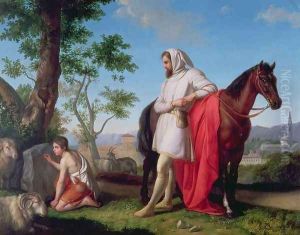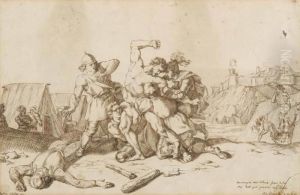Gaetano Sabatelli Paintings
Gaetano Sabatelli, born in 1798 in Florence, Italy, was an Italian painter who earned recognition for his contributions to the Romantic movement in art. He was part of a family deeply entrenched in the arts; his father, Luigi Sabatelli, was also a renowned painter, which undoubtedly influenced Gaetano's career choice and development as an artist. The Sabatelli family environment was rich with artistic fervor, providing Gaetano with an early exposure to the techniques and historical breadth of painting.
Gaetano's work is characterized by its historical and classical themes, a common choice among Romantic artists who sought to evoke emotion and grandeur through references to the past. Throughout his career, he dedicated himself to both fresco and canvas, showing a versatility in medium that allowed his work to decorate both public buildings and private collections. His style was noted for its dynamic composition and vivid portrayal of historical and mythological figures, capturing the drama and intensity of his subjects with a marked eloquence.
Despite the overshadowing fame of his father in the early years, Gaetano carved out his own niche in the Italian art scene. He became a respected teacher, influencing a new generation of artists and spreading the Romantic ideals through both his artwork and his mentorship. His contributions to Italian art were not limited to his paintings; Sabatelli also played a significant role in the academic sphere, engaging in the arts community of Florence and beyond.
Gaetano Sabatelli's death in 1866 marked the end of a career that had spanned the heart of the 19th century, a period rife with political and social upheaval that was reflected in the art of the time. Though perhaps not as widely known today as some of his contemporaries, Sabatelli's work remains a testament to the Romantic spirit, embodying the movement's passion for the past and its flair for dramatic, emotional expression. His legacy, preserved in the galleries and collections that house his pieces, continues to offer insight into the Romantic era and its artistic endeavors.

